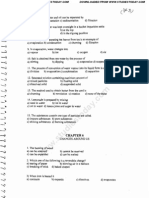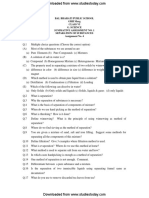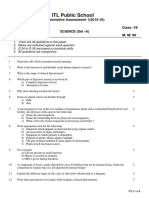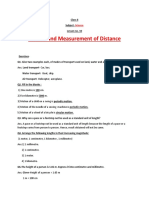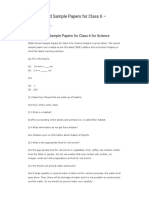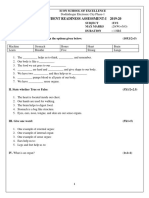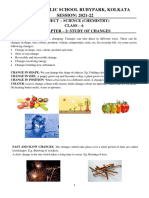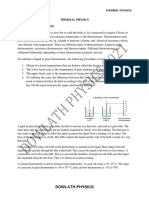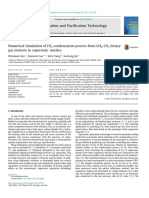Matter in Our Surroundings-competency Based Questions
Uploaded by
shehnaz aliMatter in Our Surroundings-competency Based Questions
Uploaded by
shehnaz aliMATTER IN OUR SURROUNDINGS
1. 1) A student notices that a substance “X” has fixed volume and can be transferred from one container to
another. Which option correctly classifies the substance “X”?
2. The image given below shows data about the different types of matter
3. A student adds 5 g sugar in 100 mL water. The student stirs the contents for 2 minutes. After some time, the
student notices a clear solution. Why the student was unable to see sugar particles?
(a)they are colorless
(b)they settle at the bottom
(c)they are too small to be seen
(d)they evaporate when added to water
4. A student pours 20 mL flavored water in a glass containing plain water and notices that the taste of the water
changes. The students repeat the activity for 10 times and reports that the water still has some flavor. What can
be the possible reason for this?
(a)The flavor from the water can never be removed by any method.
(b)The water is made flavored in such a way that it remains the same until it is consumed.
(c) Sieves were not used in the experiment which would have helped to remove flavored particles from the water.
(d) The particles of flavored water are very small and are transferred to plain water even when added in very small
quantities.
5. A student adds ink to water. The ink particles spread throughout the water. Which property of water allows
other particles to diffuse in it?
(a)fixed volume (b)inability to compress
(c) intermolecular spaces (d) ability to change shape
6. A student put an equal amount of potassium permanganate powder over a glass plate and in a beaker filled with
water. The student rubbed the surface of the plate and stir the contents of the beaker. It was observed that the
permanganate powder dissolved in the water and formed a colored solution. Which option explains the reason
for the student’s observation?
(a)Water is a liquid and can dissolve and solid particles in it
(b)The ability of water to exist in any state allows it to dissolve any substance
(c)Water has large intermolecular spaces which allow molecules of other substances to get between those
spaces
(d)Water particles are tightly arranged in an orderly fashion which allows the binding of the molecules of other
substances.
7. A student learns that the speed of the formation of a solution increases when the heat is supplied. How does
heat affect the formation of the solution?
(a)change in temperature increases the size of the water particles
(b)change in temperature changes the shape of the water particles
(c)change in temperature changes the kinetic energy of the particles
(d)change in temperature decreases the intermolecular spaces between the particles
8. A student puts one drop of food colour in 100 mL of water. The student notices that the food colour gradually
spreads in the water. What is the possible reason for this phenomenon?
(a)a close arrangement of the water particles
(b)the ability of the water particles to move continuously
(c)the ability of the water to stay warm at room temperature
(d)small intermolecular space between the water particles
9. A student learns that the particles of brick are arranged in a manner so that they attract each other with greater
force. Which diagram shows the arrangement of particles in a brick?
10. A student has a glass of hot water which is covered with a plate. The student wants to transfer the hot water
into another glass. The student notices that as he lifts the plate, some air flows upwards as he carefully pours
water. The student makes particle diagrams of steam, water and gas. Which diagram correctly shows the
particle arrangement?
11. What is the property of a solid substance?
(a) It retains its shape. (b) It changes its volume.
(c) It retains its colour. (d) It changes its mass.
12. A student made a model to show how particles of a substance X are arranged.
His friends observed the model and concluded that Substance X is a solid. What supports their conclusion?
(a) The particles are closely packed that allows Substance X to change its volume.
(b) The particles are fixed at their positions that allows Substance X to retain its shape.
(c) The particles are bonded to each other that allows Substance X to maintain a fixed mass.
(d) The particles are identical to each other that allows Substance X to have a uniform composition.
13. A liquid substance retains its
(a) volume but not its shape. (b) shape but not its volume.
(c) volume but not its mass. (d) mass but not its volume.
14. Mohit has a bowl filled with a Substance P. He notes some of his observations.
(a) A gas because it has a volume.
(b) A solid because it has a fixed mass.
(c) A liquid because its shape changes.
(d) A gas because objects can pass through it.
15. A student wants to make a model to show how particles of a gas are arranged. He uses red marbles, where each
marble represents one gas particle. Which model should the student make?
16. The table shows three substances and their properties.
Which substances are NOT in gaseous state?
(a) Substance A only (b) Substance C only
(c) Substance A and B (d) Substance B and C
17. A student did an activity where he put a drop of ink in water. He noticed that as soon as the drop falls in water,
the blue ink spreads throughout.
18. Why does an ice cube melt when put out of the refrigerator?
(a) because it loses heat and its particles move faster and farther causing melting
(b) because it loses heat and its particles gain kinetic energy changing from solid to liquid
(c) because it gains heat and its particles come closer since the force of attraction increases
(d) because it gains heat and its particles start moving faster and overcome the force of attraction
19. What happens when the temperature of ice is increased above 0°C?
(a) The molecules gain kinetic energy and ice changes into water
(b) The molecules lose kinetic energy and ice changes into water
(c) The molecules gain kinetic energy and ice changes into vapour
(d) The molecules lose kinetic energy and ice changes into vapour
20. Cooking gas is known as LPG (Liquified Petroleum Gas). How can a gas be liquified?
(a) when pressure is applied to the gas
(b) when temperature of the gas is increased
(c) when gas is mixed with a liquid substitute
(d) when the force of attraction between particle is reduced
21. Gases are easily compressible by applying pressure. The same volume of gas can fill up a small can and can
spread into a big room. What is the relationship between the property of gases and compressibility?
(a) Gas particles have large spaces between them, so when pressure is applied, the particles compress.
(b) Gas particles have strong intermolecular forces, so when pressure is applied, the particles liquify.
(c) Gas particles have high kinetic energy, so when pressure is applied, the particles lose their energy.
(d) Gas particles have more speed, so when pressure is applied, the particles move farther away and compress.
22. The image shows two changes.
23. The image shows three substances that can change from one physical state to another by different processes.
24. The melting point of ice is 0°C. At this temperature, both ice and water exist. However, the particles of water at
0°C have more energy than particles of ice at 0°C. What explains this?
(a) at melting point, water particles absorb more heat and change into ice
(b) at melting point, ice particles raise their temperature and change to water
(c) at melting point, water particles raise their temperature and change into ice
(d) at melting point, ice particles absorb latent heat and change into water particles
25. When ice is given heat, it reaches a temperature of 0°C and starts melting. The more heat is gained, the more it
changes to water. However, the temperature remains constant at 0°C until all ice changes to water. Why does
the temperature remain constant?
(a) because of the latent heat of fusion
(b) because of the kinetic energy of ice particles
(c) because of the latent heat of vaporization
(d) because of the kinetic energy of water particles
26. Clothes do not dry quickly when there is more humidity in air. What explains the phenomenon?
(a) high humidity decreases the rate of evaporation
(b) high humidity increases the rate of evaporation
(c) high humidity decreases the rate of condensation
(d) high humidity increases the rate of condensation
27. A student has four containers of different shapes and sizes but made of steel.
28. Kabir came back home after playing football. He felt hot and sweaty. He stood under the fan. He noticed he
started feeling cool and dry. What explains his observation?
(a) When sweat evaporates, warm air moves away from the body.
(b) When sweat evaporates, it gains heat energy from the surroundings.
(c) When sweat evaporates, it absorbs energy from the body making it cooler.
(d) When sweat evaporates, cooler air from the surroundings reaches the body.
29. During summers people sprinkle water on the rooftops because
(a) water keeps heat away from the house.
(b) when water evaporates, it absorbs the heat from the rooftops.
(c) when water condenses on the rooftops, the house remains cool.
(d) water absorbs cold from the surroundings and keeps the house cool.
You might also like
- Practice Worksheet: Subject: Science SESSION: 2020-21 Changes Around Us Grade 6100% (1)Practice Worksheet: Subject: Science SESSION: 2020-21 Changes Around Us Grade 62 pages
- CBSE Class 8 Science Sample Paper Set 5: Each Question Carriers 1 Mark: Choose The Correct Answers: (5 X 1 5 Marks)No ratings yetCBSE Class 8 Science Sample Paper Set 5: Each Question Carriers 1 Mark: Choose The Correct Answers: (5 X 1 5 Marks)3 pages
- CHEMISTRY Revision Assignment Class IX CBSENo ratings yetCHEMISTRY Revision Assignment Class IX CBSE3 pages
- Delhi Public School, Bangalore - East Chemistry Chemical Effects of Electric Current Name: Class: Viii Sec: DateNo ratings yetDelhi Public School, Bangalore - East Chemistry Chemical Effects of Electric Current Name: Class: Viii Sec: Date4 pages
- CBSE Class 6 Science Changes Around Us MCQsNo ratings yetCBSE Class 6 Science Changes Around Us MCQs2 pages
- Worksheet Class - 7 SUBJECT-Science CHAPTER - 3, Chemical Substances and Processes A. Fill in The Blanks50% (2)Worksheet Class - 7 SUBJECT-Science CHAPTER - 3, Chemical Substances and Processes A. Fill in The Blanks3 pages
- Delhi Public School Bangalore North ACADEMIC SESSION 2021-2022 Ut2 Revision Work Sheet TOPIC: Sorting Materials Into Group Answer KeyNo ratings yetDelhi Public School Bangalore North ACADEMIC SESSION 2021-2022 Ut2 Revision Work Sheet TOPIC: Sorting Materials Into Group Answer Key6 pages
- CBSE Class 6 Science Practice Worksheets PDFNo ratings yetCBSE Class 6 Science Practice Worksheets PDF2 pages
- CBSE Schools and KV Class VII SA I Science Model Question Paper 2015No ratings yetCBSE Schools and KV Class VII SA I Science Model Question Paper 20154 pages
- CBSE Sample Paper For Class 6 Science With Solutions - Mock Paper-1No ratings yetCBSE Sample Paper For Class 6 Science With Solutions - Mock Paper-111 pages
- Class: 6 Subject: Chemistry Chapter: Matter Home Work (1) : Tania Mondal100% (1)Class: 6 Subject: Chemistry Chapter: Matter Home Work (1) : Tania Mondal2 pages
- Class V Graded Worksheet 2022-2023 - KV - Maths-29-44No ratings yetClass V Graded Worksheet 2022-2023 - KV - Maths-29-4416 pages
- 1731915719maths Class Vii Half Yearly Exam Sample Paper 01No ratings yet1731915719maths Class Vii Half Yearly Exam Sample Paper 015 pages
- Motion and Measurement of Distance: ScienceNo ratings yetMotion and Measurement of Distance: Science4 pages
- CBSE Solved Sample Papers For Class 6 For ScienceNo ratings yetCBSE Solved Sample Papers For Class 6 For Science10 pages
- CBSE Class 10 Science Sample Paper Set BNo ratings yetCBSE Class 10 Science Sample Paper Set B4 pages
- Class 6 - Chapter 4 - Sorting Materials Into Groups100% (1)Class 6 - Chapter 4 - Sorting Materials Into Groups3 pages
- Class 6 Science Chapter 10 Motion and Measurement of DistancesNo ratings yetClass 6 Science Chapter 10 Motion and Measurement of Distances5 pages
- Study Material Class 6 Chemistry Study of ChangesNo ratings yetStudy Material Class 6 Chemistry Study of Changes8 pages
- NCERT Exemplar Problems From Class 6 Science Components of FoodNo ratings yetNCERT Exemplar Problems From Class 6 Science Components of Food8 pages
- Question Bank - Synthetic Fibres and Plastics100% (1)Question Bank - Synthetic Fibres and Plastics5 pages
- CLASS 4 EVS PWS Feeling Around With Eyes Shut - ShwetaNo ratings yetCLASS 4 EVS PWS Feeling Around With Eyes Shut - Shweta3 pages
- Chemistry MCQ Class 6 Chapter 4 Sorting Materials Into GroupsNo ratings yetChemistry MCQ Class 6 Chapter 4 Sorting Materials Into Groups6 pages
- Lesson: 1 - Food - Our Basic Need I. Word Bank: Class 4-Evs March Notes of LessonNo ratings yetLesson: 1 - Food - Our Basic Need I. Word Bank: Class 4-Evs March Notes of Lesson2 pages
- Class 10TH Scince Bridge Course 2024-25No ratings yetClass 10TH Scince Bridge Course 2024-2540 pages
- 6 Science Sample Paper Class 6 2024-2025 FinalNo ratings yet6 Science Sample Paper Class 6 2024-2025 Final4 pages
- CBSE Sample Papers Social Science Class 8 Set 1 PDFNo ratings yetCBSE Sample Papers Social Science Class 8 Set 1 PDF4 pages
- Amity International School Noida Class: VI Air Around Us Science WorksheetNo ratings yetAmity International School Noida Class: VI Air Around Us Science Worksheet3 pages
- Chemistry Worksheet Class 7 On Chapter 6 Physical and Chemical Changes With Answers Set 1No ratings yetChemistry Worksheet Class 7 On Chapter 6 Physical and Chemical Changes With Answers Set 15 pages
- Maths Class X Chapter 12 Surface Areas and Volumes Practice Paper 11No ratings yetMaths Class X Chapter 12 Surface Areas and Volumes Practice Paper 114 pages
- Subject: Science Grade: VI Topic: Components of Food (Answer Key)No ratings yetSubject: Science Grade: VI Topic: Components of Food (Answer Key)4 pages
- DSSSB DOE PRT 2019.11.11, Shift 3 - 04.30PM - 06.30 PM, EnglishNo ratings yetDSSSB DOE PRT 2019.11.11, Shift 3 - 04.30PM - 06.30 PM, English47 pages
- Thermal Runaway Management of Li Ion Battery Using PCM ANo ratings yetThermal Runaway Management of Li Ion Battery Using PCM A10 pages
- Module-I Air Refrigeration: Subject Code: FOOD315 Subject Name: Food Engineering-IINo ratings yetModule-I Air Refrigeration: Subject Code: FOOD315 Subject Name: Food Engineering-II6 pages
- Properties of Common Liquids Solids and Foods 2No ratings yetProperties of Common Liquids Solids and Foods 22 pages
- Separation and Purification Technology: Wenjuan Sun, Xuewen Cao, Wen Yang, Xuetang JinNo ratings yetSeparation and Purification Technology: Wenjuan Sun, Xuewen Cao, Wen Yang, Xuetang Jin12 pages
- Experiment 11 Latent Heat of Fusion of WaterNo ratings yetExperiment 11 Latent Heat of Fusion of Water4 pages
- IB Physics 2025 Topic 2 Definitions Tiber TutorNo ratings yetIB Physics 2025 Topic 2 Definitions Tiber Tutor1 page












